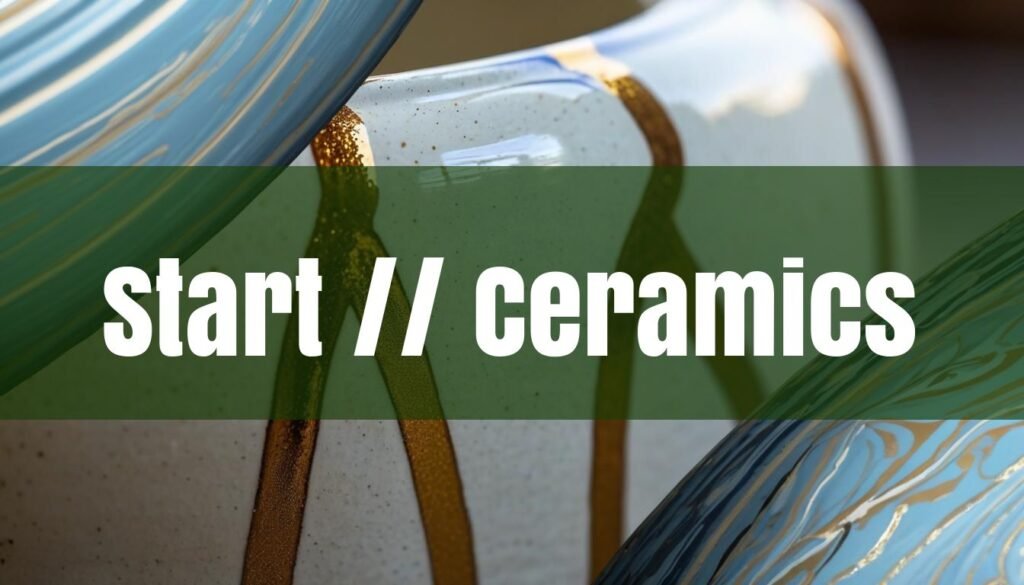Starting your ceramics journey at home can be an incredibly rewarding experience, allowing you to explore your creativity and craft beautiful, functional pieces. It might seem daunting at first, but with the right approach and a little patience, you can set up a home studio and begin creating pottery that reflects your unique style. This article will guide you through the essential steps, from gathering the necessary equipment to mastering basic techniques and finding alternatives to a traditional kiln.
First, let’s talk about the initial investment. You don’t need a fully equipped professional studio to get started. Several beginner-friendly pottery kits are available that include the essentials. For example, the Beginner Pottery Kit – Ceramic from Pottery with a Purpose costs $59.00 and includes premium locally-made ceramic clay, carving tools, detailed instructions for making a ceramic mug, pinch pot, hanging planter, or footed pot, a small smoothing sponge, and even a plantable wildflower seed coaster. Similarly, the Sculpd Pottery Kit, starting at $65, provides 4.4lbs of clay, pottery carving, shaping, and cutting tools, white acrylic eggshell paint, waterproof glossy or matte varnish, ultra-fine bristle paintbrushes, and a potter’s sponge for smoothing. These kits are a great way to familiarize yourself with the tools and materials without breaking the bank. For those looking for more comprehensive setups, Bailey Pottery offers Studio Starter Packages for both wheel throwing and hand-building, ranging from $2,031.00 to $6,771.00.
Choosing the Right Clay
Choosing the right type of clay is crucial for beginners, as different clays have different properties and firing temperatures. Earthenware clay is a popular choice due to its relatively low firing temperature (1,800 to 2,200 degrees Fahrenheit) and ease of use. It’s versatile and suitable for making simple objects like bowls, plates, and jars. However, earthenware is porous and not as strong as other clays, so it’s best for decorative items or pots used for growth. Stoneware clay, fired at higher temperatures (2,300 to 2,400 degrees Fahrenheit), is stronger and more durable, making it suitable for functional ware like cooking pots and vases. It is less porous than earthenware and can be glazed and decorated. Porcelain clay, fired at the highest temperatures (2,400 to 2,600 degrees Fahrenheit), is the strongest and least porous, ideal for fine art objects and tableware, but it requires more skill to work with. Air-dry clay is an alternative that hardens naturally without firing, making it perfect for beginners and small-scale projects, though it’s not as durable as fired clay. Polymer clay also hardens at low temperatures, in a home oven. To learn more, see our guide on different types of clay.
Hand-Building Techniques
Hand-building techniques are fundamental for creating ceramic forms without a pottery wheel. Three basic methods are pinch pots, coil building, and slab construction. To make a pinch pot, start with a ball of clay and insert your thumb into the center. Slowly pinch and stretch the clay around the initial hole to create the desired shape, using your fingers to thin the walls while applying pressure from both the inside and outside. Smooth the outside surface and trim the rim to level it. Coil building involves rolling out coils of clay and attaching them to create the walls of your pot. Start by patting out a slab for the base and rolling out a coil about half an inch in diameter. Attach the coil by pinching it firmly into the base around the circumference. Pinch the coil thinner between your thumb and forefingers until the wall is the desired thickness. Continue adding coils, pinching, scraping, and smoothing until you reach the desired height. Slab construction is ideal for creating square or cylindrical forms. Roll out a flat slab of clay and cut out the bottom and sides. Score the edges where the slabs will connect and apply slip (thin watery clay) to both surfaces. Firmly press the slabs together and roll a thin coil of clay into the inside joint for added strength. Smooth the outside of the joint until no trace remains. For a more in-depth exploration, see our article on mastering hand-building pottery.
Firing Ceramics at Home
Firing ceramics traditionally requires a kiln, but there are alternative methods for those without access to one. Polymer clay and air-dry clays can be hardened in a conventional kitchen oven, following the manufacturer’s instructions for temperature and time. However, these methods do not allow for glazing. Raku firing is a traditional Japanese technique that can be adapted for home use, although it requires a well-ventilated outdoor space. This involves heating the ceramic pieces in a barrel using wood or other combustible materials until they are glowing red, then removing them and placing them in containers with combustible materials like sawdust or newspaper to create a reduction atmosphere. Pit firing, also known as smoke firing, is another traditional method that involves digging a pit in the ground and burying the clay pieces with combustible materials. The fire is lit and the pieces are left to bake overnight under the ashes. Both Raku and pit firing produce unique, earthy tones but require careful monitoring and safety precautions. A relatively modern innovation is the microwave kiln, a small, kiln-like device that fits inside a standard microwave oven. It uses the microwave’s energy to generate temperatures high enough to fire small pieces of clay, glass, or metal clay. While the size of pieces you can fire is limited, this method is an affordable and accessible option for hobbyists.
Setting Up a Workspace and Safety Precautions
Creating a dedicated workspace is essential for a productive and safe ceramics practice. Choose a well-ventilated area with enough space to work comfortably. Cover your work surface with a material that is easy to clean, such as a plastic sheet or a large tile. Keep your tools organized and within easy reach. When working with clay, always wear appropriate safety gear, including gloves and a dust mask, to protect your skin and respiratory system. Ensure proper ventilation to minimize exposure to clay dust, which can be harmful if inhaled over long periods. When firing ceramics, especially using alternative methods like Raku or pit firing, take extra precautions. Wear heat-resistant gloves and eye protection, and conduct the firing in a safe, open area away from flammable materials and children or animals. Always have a fire extinguisher and a water source nearby in case of emergencies.
Common Problems and Solutions
Beginners often encounter common problems such as cracking, warping, or glaze issues. Cracking can occur if the clay dries too quickly or unevenly. To prevent this, dry your pottery slowly, covering it loosely with plastic to slow the drying rate. Warping can result from inconsistent wall thickness or improper support during drying. Pay close attention to maintaining even thickness as you shape your piece and use appropriate supports to prevent sagging. Glaze issues, such as uneven finishes or running, can be avoided by applying glaze evenly and in thin layers. Ensure your piece is clean and dry before glazing and test your glaze on a sample piece to see how it reacts during firing. Air bubbles in the clay can cause explosions in the kiln, so always wedge your clay thoroughly to remove any air pockets. If cracks appear when attaching handles or other elements, compress the clay well and ensure a strong bond between the pieces by scoring and slipping both surfaces before joining them.
Starting ceramics at home is a journey filled with creativity, learning, and occasional challenges.
By understanding the basics, choosing the right materials, mastering fundamental techniques, and prioritizing safety, you can create beautiful ceramic pieces that reflect your personal style. Embrace the process, learn from your mistakes, and enjoy the rewarding experience of bringing your artistic visions to life.





